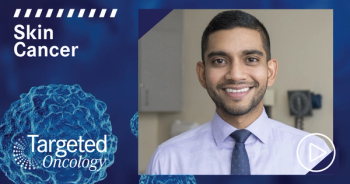
Risk Factors & Prevention of Advanced CSCC
Shubham Pant, MD:I just want to touch on prevention. Is it the same concept? Do you use sunscreen?
Nikhil Khushalani, MD:Correct. And that’s what we typically will recommend to these individuals as well: appropriate sunscreen measuresat least an SPF 15, preferably 30 or higher. Appropriate sun-protective measures such as, you know when you’re out, a wide-brimmed hat, or preferably long-sleeved ultraviolet-protective clothes. These would be things that we would typically recommend to patients, particularly if they already meet their clinical phenotype. So the clinical phenotype classically would mean somebody who is fair skinned and has blue eyes and blond or red hair.
Shubham Pant, MD:Just like me I guess.
Nikhil Khushalani, MD:Or us, both of us.
Shubham Pant, MD:I need SPF 100, I think.
Nikhil Khushalani, MD:So these are patients who are, or individuals who are, at much higher risk of developing skin cancers. Now once they already have a skin cancer, they actually have a higher incidence of developing a second nonmelanoma keratinocyte cancer, almost a 40% increase. And if they’ve already had 1 more, it’s almost an 80% increase. So these are patients who’ve already had what we called a field-cancerization defect because of chronic, for example, UV-B exposure.
I think 1 thing that I really would like to stress, it’s not just ultraviolet B. It is ultraviolet-light A as well. And sometimes that is actually sort of underrecognized because ultraviolet-light A, for example, is what we use in tanning beds and tanning salons. So again, that’s a public health measure. It’s important to recognize that tanning beds do increase the incidence of developing not just melanoma but other nonmelanoma skin cancers, including CSCC.
Patients who have been treated for years with PUVA light therapypsoralen and ultraviolent-light A therapy—for example, in psoriasis, have a higher incidence of developing CSCC as well.
So these are things that we have to keep in mind and certainly educate the general public. When they’re going out into the sun, they need to take adequate protection measures. One of my dermatologists, who we work with very closely, he says, “I just take my ointment right after the shower,” just puts a little bit on his face; it has the adequate sunscreen. And he says that, “Therefore, at least I start off the day being protected by going out, particularly in a place like Florida.” That’s important.
Shubham Pant, MD:Really in a place like Florida. So it’s almost akin to when smokers come to us with lung cancer and they say, “Should I quit smoking?” It does make sense for them to quit smoking. And similarly, if patients come to you and have never used sunscreen before but have this malignancy, you say, even though we treated you and it’s gone away, or it’s in remission or something, you now need to start using sunscreen to prevent a second one.
Nikhil Khushalani, MD:I would absolutely recommend that. To try to at least decrease the incidence of developing a second skin cancer. That becomes even particularly more important in the transplant population, the solid-tumor transplant population. Because in those individuals, there’s a higher risk related to cumulated sun exposure as well, after the transplant and the association with immunosuppression there. So I think trying to do these simple measures hopefully will go a long way in trying to reduce the disease burden from this very common skin cancer, very treatable skin cancer, in the early stages. But there’s that small percentage of patients who eventually go on to developing advanced disease that becomes far more difficult to treat.
Shubham Pant, MD:Prevention is better than cure.
Transcript edited for clarity.







































